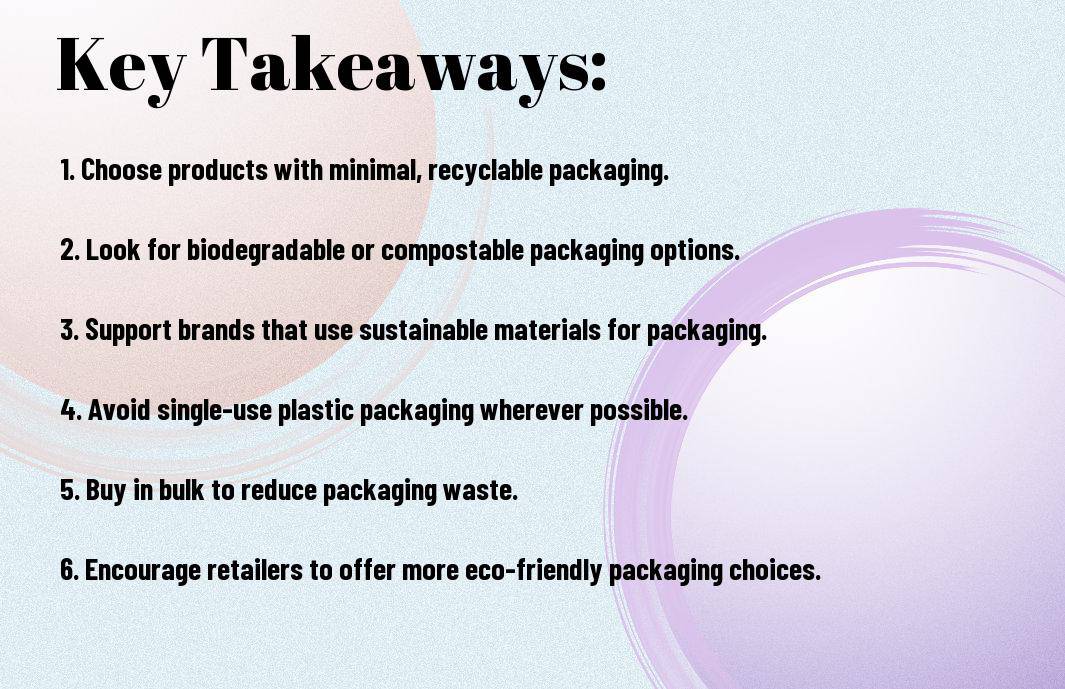As a conscientious consumer, you have the power to make a positive impact on the environment by supporting eco-friendly food packaging in your everyday purchases. In this blog post, we will explore the various ways in which you can help reduce plastic waste and promote sustainable packaging when shopping for groceries and other food products. By making informed choices and supporting companies that prioritise environmentally-friendly packaging, you can contribute to a healthier planet for future generations.
Key Takeaways:
- Look for eco-friendly packaging: Consumers can actively seek out products with recyclable, biodegradable, or compostable packaging to support eco-friendly initiatives in their everyday purchases.
- Support sustainable brands: Choosing to buy from companies that prioritise sustainable packaging practices can encourage more businesses to adopt environmentally-friendly alternatives.
- Reduce single-use plastic: Opting for products with minimal or no plastic packaging, or reusing and repurposing existing packaging, can help consumers reduce their environmental impact and support eco-friendly packaging in the long run.

Eco-Friendly Food Packaging and Its Impact
When it comes to making eco-friendly choices in your everyday purchases, it’s important to consider not only the product itself but also its packaging. The impact of food packaging on the environment is significant, and by choosing eco-friendly options, you can make a positive difference. To learn more about making sustainable choices when shopping, check out this article on How to Make Eco-Friendly Purchases When Shopping.
What is Eco-Friendly Food Packaging?
Eco-friendly food packaging refers to packaging materials that are sustainable, recyclable, biodegradable, or compostable. This type of packaging is designed to have minimal impact on the environment, from production to disposal. By choosing eco-friendly food packaging, you can significantly reduce the environmental footprint of your food consumption.
How does Eco-Friendly Food Packaging Impact the Environment?
Eco-friendly food packaging has a positive impact on the environment in several ways. Firstly, it reduces the amount of plastic and non-biodegradable waste that ends up in landfills and oceans. This helps to protect wildlife and ecosystems from harmful pollution. Additionally, eco-friendly packaging often requires fewer resources to produce, resulting in lower energy consumption and carbon emissions. By choosing eco-friendly food packaging, you are supporting a more sustainable and responsible approach to food consumption, which is crucial for the health of our planet.
Consumer Habits that Encourage Eco-Friendly Packaging
As a consumer, your everyday habits play a crucial role in supporting eco-friendly food packaging. By making conscious choices and adopting sustainable practices, you can contribute to reducing the environmental impact of food packaging and encouraging more eco-friendly alternatives.
Everyday Purchases: A Powerful Tool for Change
Your daily purchases hold significant power in driving change towards eco-friendly packaging. By opting for products that utilise sustainable and recyclable packaging, you are sending a clear message to manufacturers and retailers that eco-friendly options are in demand. Your choices can influence the market and encourage more companies to switch to environmentally responsible packaging solutions.
Ways to Support Eco-Friendly Packaging through Consumer Choices
When making your purchasing decisions, consider choosing products that come in packaging made from biodegradable or compostable materials. You can also look for items with minimal or no packaging, as this can significantly reduce the amount of waste generated. Additionally, prioritise products that are packaged in materials that are easily recyclable to minimise their impact on the environment. By doing so, you are actively supporting the shift towards eco-friendly packaging and promoting a more sustainable future.
The Challenges and Opportunities in Eco-Friendly Food Packaging
When it comes to eco-friendly food packaging, there are both challenges and opportunities for improvement. Understanding these factors is essential for making informed choices as a consumer and for driving change as a manufacturer.
Challenges Faced by Consumers and Manufacturers
As a consumer, one of the main challenges you may face is the limited availability of eco-friendly packaging options. It can be difficult to find products that are packaged in sustainable materials, and this may limit your ability to make environmentally friendly choices. Additionally, eco-friendly packaging options are often more expensive, which may be a barrier for some consumers. On the other hand, manufacturers face challenges such as the higher cost of producing eco-friendly packaging and the limitations of certain materials in terms of functionality and durability.
Opportunities for Improvement and Growth in Eco-Friendly Packaging
Despite the challenges, there are opportunities for improvement and growth in the realm of eco-friendly food packaging. As a consumer, you have the opportunity to demand more sustainable options by actively seeking out and supporting products with eco-friendly packaging. Your choices can influence the market and encourage manufacturers to invest in sustainable packaging solutions. Manufacturers have the opportunity to develop innovative eco-friendly packaging materials and processes, capitalising on the growing demand for sustainable products. By investing in research and development, they can create packaging that is not only environmentally friendly, but also cost-effective and functional.
Supporting Eco-Friendly Food Packaging in Your Everyday Purchases
With these considerations in mind, you can make a significant impact on supporting eco-friendly food packaging in your everyday purchases. By choosing products with minimal packaging, opting for materials that are easily recyclable or biodegradable, and supporting brands that prioritise sustainable packaging practices, you are sending a clear message to the industry. Your choices as a consumer can drive the demand for eco-friendly packaging, prompting more companies to adopt greener practices. Remember, every small decision you make in the grocery store can contribute to a larger, positive change for the environment.
FAQ
Q: Why is eco-friendly food packaging important?
A: Eco-friendly packaging helps reduce the environmental impact of food production and consumption by minimizing waste, conserving resources, and decreasing pollution.
Q: What are some examples of eco-friendly food packaging materials?
A: Examples of eco-friendly food packaging materials include biodegradable plastics, compostable packaging, recycled cardboard, and sustainable materials such as bamboo and sugarcane.
Q: How can consumers identify eco-friendly food packaging?
A: Consumers can look for eco-friendly labels such as “biodegradable,” “compostable,” “recycled,” and “sustainably sourced” on food packaging. They can also research brands that are known for using eco-friendly materials.
Q: What are the benefits of supporting eco-friendly food packaging in everyday purchases?
A: Supporting eco-friendly food packaging not only helps protect the environment, but it also promotes sustainable practices in the food industry and encourages businesses to adopt more environmentally friendly packaging solutions.
Q: How can consumers influence companies to switch to eco-friendly food packaging?
A: Consumers can make their voices heard by contacting companies to express their desire for eco-friendly packaging, sharing their preferences on social media, and supporting businesses that prioritise sustainable packaging options. By voting with their wallets, consumers can drive change in the industry.



